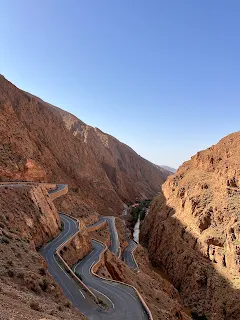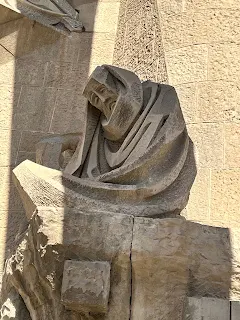Day 1: Arrival in Casablanca (September 27)
This year our annual girls trip was to to the city of Sunsets and Souks, Morocco. While our Moroccan journey began in the city of Casablanca, we were simply transiting through that city upon arrival. Most first timers either begin their itinerary in Casablanca or in Marrakesh. No matter where the trip starts, the trip circuit is the same. It either goes clockwise or anti-clockwise. After a long flight, the first of our girls friends arrived late at night, greeted by the warm embrace of the city. She settled into Hotel Kenzi Basma, about 20 min from the airport, ready to embark on the adventure ahead.
Day 2: Transition to Marrakech (September 28)
The next day started with a bunch more of us arriving from different parts of the world, gathering of friends, at Casablanca Airport. We had pre-arranged our pickup with our tour guide with a van. Together, we set off for Marrakech, the vibrant “Red City.” After settling into Riad La Croix Berbere Deluxe, located in Marrakesh medina (historical city center), the evening was ours to explore and unwind.
A Moroccan riad is unique for its central courtyard, intricate tilework, serene ambiance, rooftop terraces, and personalized hospitality, offering an authentic cultural experience. While most Riads are located in the medinas of Moroccan cities like Marrakech or Fes, some riads can also be found in quieter outskirts or rural areas, offering a peaceful retreat with the same traditional charm.
That evening, we toyed with the idea of visiting the serene Majorelle Gardens but left it for another day. The remainder of this day was spent hanging out in the market square (which was only a short walk away) and catching up with friends.
Day 3: Exploring Marrakech (September 29)
After a sumptuous Moroccan breakfast, a guided tour of Marrakech was the highlight of the day. The lush Yves Saint Laurent Gardens greeted us first, a serene oasis amidst the city’s energy. We admired the towering Koutoubia Mosque from the outside and meandered through the lively souks and the historic Jewish Quarter. At the Bahia Palace, history whispered through intricately adorned walls.
The Marrakech medina is a bustling UNESCO World Heritage Site, known for its vibrant souks, narrow winding alleys, historic palaces, mosques, and bustling Jemaa el-Fnaa square, all steeped in rich Moroccan culture and history.
As the day waned, the Riad welcomed us back for a relaxing evening and a rooftop dinner of traditional Moroccan fare.
One special activity was a hammam, a hot water and steam-filled traditional spa experience focused on cleansing, exfoliating the skin with black soap, scrubbing with a kessa glove, and applying ghassoul clay. Treatment delivered by other women (or men), Hammams are an integral part of Moroccan culture.
We stopped at a cooperative to buy some Argon oil. While the oil seemed very pure, it was rather expensive as we found out later.
Day 4: The Road to Dades Valley (September 30)
Departing Marrakech, we ventured into the breathtaking High Atlas Mountains. The winding Tizi N’Tichka Pass offered incredible panoramas. A stop at Ait Ben Haddou transported us to a bygone era of earthen kasbahs and movie sets. This UNESCO World Heritage Site and an ancient fortified village, located near Ouarzazate, showcases traditional Berber construction and has served as the backdrop for iconic films like Gladiator, James Bond and Game of Thrones. Its dramatic landscape and preserved cultural heritage make it a must-visit destination.
We had traditional lunch which included dishes like tagines (slow-cooked stews with meat, vegetables, and spices), couscous (steamed semolina served with vegetables and meat), harira (hearty soup with lentils and chickpeas), refreshing raw salad with cucumbers, tomatoes, and parsley and mint tea, a staple drink. The food characterized by aromatic spices like cumin, saffron, and cinnamon, and a blend of sweet and savory flavors the lunch was only overshadowed by the ancient city.
Continuing through Skoura and Kelaa Mgouna, we reached the enchanting Dades Valley, where rock formations and lush gardens framed our stay at Kasbah Didis.
Day 5: Into the Merzouga Desert (October 1)
We journeyed deeper into Morocco, visiting the awe-inspiring Todgha Gorges before reaching the golden dunes of Erg Chebbi. Camel trekking led us into the heart of the Sahara, where a luxury camp awaited. The evening brought a fiery sunset, dinner, music and dancing around a fire pit— and stargazing under the expansive desert sky.
En route, we stopped at a local shop to buy a desert turban (veil), a long piece of fabric, made of cotton, wrapped around the head and face to protect against harsh sun, wind, and sand in the desert. It is especially popular among the Berber people of North Africa. Be aware of local hawkers charging an arm and a log for their veils, unlikely you will ever use it again, but it makes a good Insta-worthy picture.
Day 6: From the Desert to Fes (October 2)
The day began with a magical desert sunrise. From Merzouga, we traversed the Ziz Valley, capturing snapshots of palm groves and pausing for lunch in Midelt. En route to Fes, we drove by the Cedar Forest, where playful monkeys swung from the trees. By evening, the historical city of Fes welcomed us warmly at Riad au 20 Jasmins.
While tagine was delightful for the first few days, by day four, having it for both lunch and dinner started to feel a bit repetitive. Its mild flavors, though comforting, left us craving something spicier. Luckily, we had packed an Indian spice mix, which quickly became our secret weapon. We sprinkled it liberally on salads, yogurt, and even tagine, instantly transforming the dishes. To our surprise, the kebabs at roadside eateries turned out to be exceptionally flavorful, offering a welcome change. In Fez and other touristy areas, we also began exploring Chinese, Thai, and Indian cuisines, adding some much-needed variety to our meals.
Day 7: Discovering Fes (October 3)
With the guidance of a knowledgeable local expert, we delved into the spiritual and cultural heart of Morocco—Fez. The grandeur of the Royal Palace gates, coupled with the intricate artisan workshops of Fes el Bali, revealed stories etched into every corner of the ancient city. Wandering through the vibrant souks and narrow alleys felt like stepping into a living museum. The iconic tanneries, with their vibrant dye pits, offered a glimpse into traditional leather-making techniques. Yet, the tannery experience was bittersweet; the pungent, lingering odor surrounding the tanneries made it a sensory challenge. It was a visit that leaves a lasting impression—and since then, I've found myself steering clear of real leather.
While in Fez, we stumbled into a local music festival, I believe its called the Fez Festival of Sufi Culture, an event where many local Sufi groups perform music and dance as they move in a procession through the medina. The procession with filled with small local bands singing and dancing, people lining both sides of the narrow medina streets and creating a lively atmosphere in the historic city center. It's was a great experience in traditional Moroccan music up close and personal.
As the day drew to a close, the peaceful ambiance of the Riad offered a perfect retreat, balancing the intensity of the city with serene comfort.
Day 8: Journey to Chefchaouen (October 4)
The drive to Chefchaouen, the “Blue Pearl,” was a visual treat, with the Rif Mountains painting the landscape. Wandering through its picturesque blue streets, we found ourselves enchanted by the Utta Hammam Square and Ras El Ma springs. At Dar Mounir, we rested amidst the charm of this unique town.
This was by far the prettiest town/city and also the smallest. Walking from one end to another was easy. Walking late night was safe. If you plan to buy Argon oil, we found that it was pure and cheaper than all other towns here. The bottles come in varying sizes.
Right in the city, is a popular hike to view the sunset, leading to a small Spanish Mosque. Built in the 1920s, this mosque sits atop a hill just east of the medina. The easy and leisurely trail is only approx 1.5 kilometers (about 1 mile) round trip taking 20 to 30 minutes each way. Upon reaching the summit, you are rewarded with panoramic views of the Blue City and the surrounding Rif Mountains, making it an ideal spot to witness the sunset.
Day 9: Chefchaouen to Casablanca (October 5)
Bidding farewell to Chefchaouen, we returned to Casablanca. A visit to the iconic Hassan II Mosque capped off our Moroccan adventure. At night we took a quick trip to the waterfront and then settled into Hotel Kenzi Basma for the final night.
Day 10: Departures and Farewells (October 6)
The trip concluded with a city tour of Casablanca before heading to the airport. Goodbyes marked the end of a journey filled with incredible memories, laughter, and an appreciation for Morocco’s hospitality, beauty and culture.
 |
| Hassan II Mosque, Casablanca |
 |
| Chefchouan |
 |
| Alleys of Medina |
 |
| Spice shops in the medina |
 |
| Tannery in Fez |
 |
| Narrow alleys of a medina |
 |
| Royal Palace, Fez |
 |
| Sahara, Merzouga Desert |
 |
| Zik Zak road, Dades Valley |
 |
| Riad |
















